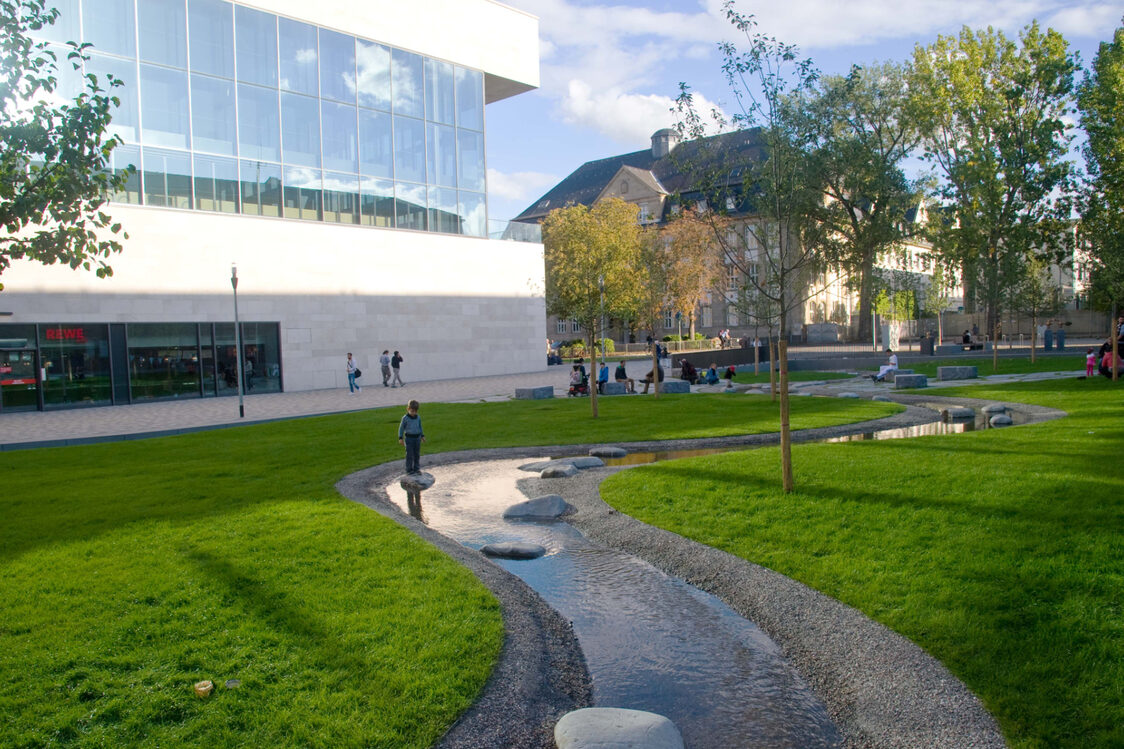Green and open space development
The landscape forms the basis of all planning. Wiesbaden lies between the Taunus and the Rhine - this special location shapes the city and its development.
Wiesbaden: The city from the landscape
The Taunus slopes, stream valleys, springs and the Rhine make Wiesbaden unique. This landscape has always been an important part of urban planning.
The "green-grey-blue" Wiesbaden was created in the 19th century. The triad of "water - villas - green paradises" was the guiding principle of urban development. At that time, Wiesbaden was growing rapidly: over 100,000 people lived here and up to 200,000 spa guests came every year.
Even during the urban development of the time, it was important to connect the landscape with the city and make it a tangible experience. Many hiking trails, observation towers and high points were created, which were given special prominence, such as the Neroberg or Biebrich water tower. In addition, the inner-city streets created visual links from the city to the Taunus. Evidence of garden art can be found in Wiesbaden and is typical of the city.
The special combination of nature and city still characterizes Wiesbaden's identity today.
Quality instead of quantity
In the 20th century, the focus in Wiesbaden was initially on representative greenery. Later, the main aim was to offset the negative consequences of dense development. Green spaces were intended to provide better living conditions. One example of this is the generous green spaces in Wiesbaden-Klarenthal and Schelmengraben, which were created according to the principle of the "structured and loosened-up city".
Today, it is not just about the quantity, but also the quality of the open spaces: open spaces are a place of urban culture and provide space for different lifestyles.
Modern green and open space planning takes many aspects into account: Urban, transportation and environmental planning intertwine. Different requirements and uses come together in one place. Multidimensional concepts are needed to ensure that open spaces meet the challenges of our time. The aim is to create open spaces that are sustainable, flexible and usable for everyone.
Dieter Kienast, Swiss landscape architectOur work is the search for a nature of the city whose color is not only green, but also gray. The nature of the city means trees, hedges, lawns, but also water-permeable pavement, wide spaces, strict canals, high walls, open fresh air or visual axes, the center and the edge.
Open spaces for a sustainable city
Green-grey-blue open spaces - what does that mean?
- Green: trees, hedges, parks such as the Kurpark or the Warme Damm.
- Gray: squares, walls, water-permeable surfaces.
- Blue: streams, rivers, canals.
Today, open spaces must meet the needs of many people - regardless of their stage of life, origin or lifestyle.
Climate change and environmental issues are also placing new demands on our open spaces:
- Water is a key element of open space development. For example, they cool the environment and retain water.
- Stream valleys in Wiesbaden are important for the urban climate and also serve as recreational areas.
Open spaces are places that create identity. They create space for encounters and help us to adapt our cities to new challenges.
The goal: sustainable urban development that relies on open spaces.
For some years now, the banks of the Rhine and Main have been the focus of open space development. Here, measures on the banks are regularly implemented using funds from the Regionalpark umbrella organization.
Further information
Urban planning office
Address
65189 Wiesbaden
Postal address
65029 Wiesbaden
Arrival
Notes on public transport
Bus stop Statistisches Bundesamt; bus lines 16, 22, 27, 28, 37, 45, X26, x72, 262
Telephone
Opening hours
Please make an appointment.
Information on accessibility
- Barrier-free access is available
- The WC is barrier-free
